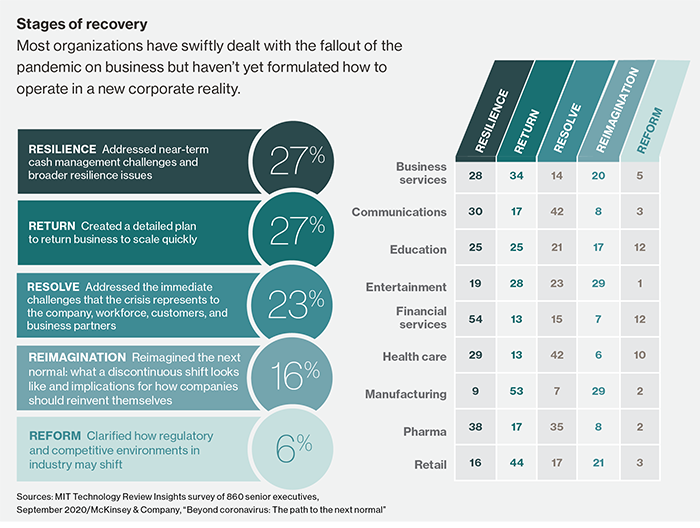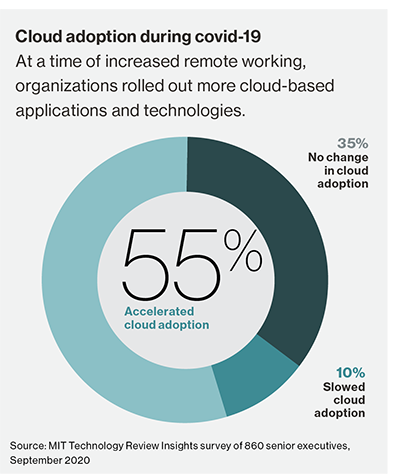Collaborative planning in an uncertain world
Corporate planning is difficult in the best of times, let alone in the middle of a global health crisis. The coronavirus pandemic has made strategic planning harder because of economic upheaval, personal stress, work and lifestyle changes, and the unpredictability of everything.

This report explores how companies worldwide conduct strategic enterprise planning—particularly in uncertain times. MIT Technology Review Insights, in association with Oracle, surveyed 860 executives in various departments including finance, supply chain and logistics, human resources (HR), and information technology.
We also spoke in depth with leaders at several companies to learn how they plan and collaborate, from general business processes to their investment in artificial intelligence and cloud-based applications, and how finance, HR, and operations are evolving to support those efforts. The executives share their own processes and help readers identify techniques to adopt. Here are the key findings from our research:
Months after the outbreak, most organizations are still coping with the initial challenges. Half of surveyed organizations are still in the process of dealing with the current emergency, responding to short-term issues and addressing financial resilience, such as staff availability and income disruption. At the same time, some businesses, such as cleaning supplies manufacturers, have seen sales spike precipitously and are struggling to meet demand. Organizations experiencing both sides of the challenge may have ideas about how to move forward, but they have yet to materialize.
Organizations are working on formulating plans to move forward. Nearly a quarter are making the necessary adjustments with a future plan in mind, and another quarter are actively working toward a new plan: 16% have reached a “reimagine the future” stage, and 6% are looking at how their new direction might affect practical matters such as standards and compliance.
Technology is seen as a useful aid in planning endeavors. As a result of the pandemic, more than half of organizations accelerated cloud adoption. This segment is 50% more likely to have addressed pandemic challenges to business, the workforce, and customers. The survey also shows that AI and machine learning have gained the trust of large companies worldwide. And three quarters of respondents expect connected enterprise planning—which combines financial, operational, and workforce planning with cloud-based internet of things, AI, and prescriptive analytics—to improve collaboration and decision-making.
Planning is an all-hands-on-deck effort. All business departments have a part to play in planning for future success, including HR and supply chain—and finance is the glue that bonds them. But for collaboration to work, data can’t exist in silos spread across the business—consistent, accessible, and accurate data drives business planning and execution.
Some organizations are more welcoming to technology than others. A minority, 10%, are reducing their use of cloud technologies as a result of the pandemic. They’re technology laggards in several ways, from keeping HR and finance data in separate silos to eschewing connected enterprise systems in favor of spreadsheets. Such old-school ways may have made the companies weaker; for example, if they have not digitized their businesses, they may lack the insights that would give them more justification to invest at this critical time.

The road to recovery
It’s a huge understatement to say the pandemic upended everything. The worldwide economy has been affected, every industry was blindsided, and most organizations needed to make painful decisions. Others benefited, such as detergent manufacturers, workout equipment companies, and recreational vehicle sellers, but even those faced supply chain challenges.
Yet, organizations must move on. “In this unprecedented new reality, we will witness a dramatic restructuring of the economic and social order in which business and society have traditionally operated,” write McKinsey & Company’s Kevin Sneader and Shubham Singhal in “Beyond coronavirus: The path to the next normal.”

After the initial survival-response questions, businesses and individuals are puzzling over a long list of additional concerns: How can we continue to thrive? How will we handle new employee onboarding as we scale? What’s the next market we want to enter? What changes do we need to make to cope with the long-lasting social effects of the virus?
A survey of 860 business professionals conducted by MIT Technology Review Insights, in association with Oracle, shows that after the initial shock, most organizations are hard at work planning, looking for—and sometimes finding—a road to recovery and a return to growth. It also suggests the ones that are the most enthusiastic about cloud and advanced technologies such as AI and machine learning are not only more likely to get past the roadblocks the pandemic threw up but to course-correct toward success.
Author Maya Angelou might have been speaking of individuals when she said, “You may not control all the events that happen to you, but you can decide not to be reduced by them”—but the sentiment applies equally well to communities and organizations during this unprecedented time.
Download the full report.
This content was produced by Insights, the custom content arm of MIT Technology Review. It was not written by MIT Technology Review’s editorial staff.

